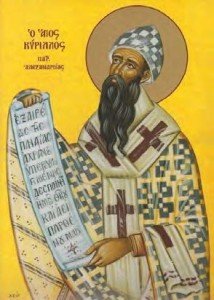Although Cyril’s Christology needed to be more clearly defined, the Council of Chalcedon did not, in any way, disavow Cyril. It only attempted to answer the legitimate fears of the Antiochians that Cyril had fallen into Apollinarianism. Not only does the Chalcedonian definition itself specifically ascribe the title of Theotokos to the Virgin Mary, but – after some hesitation in the second half of the fifth century – the Eastern church at the Fifth Council (553) reaffirmed that the criteria of Christological truth resides in Cyril and Chalcedon.
I think that it is important to note that there were several major schools of theology in the early Church. They were connected with two of the major Churches, the Church of Antioch and that of Alexandria. They were two of the five primary Patriarchates (the other three primary Patriarchates were Jerusalem, Rome and Constantinople).
We must remember that Cyrillian Christology implied that divinity and humanity were compatible, but also that Christ’s own particular humanity, although it was assumed with all the consequences of its incompleteness, was deified through the cross and resurrection and thus revealed the true purpose of creation in conformity with its divine model. Christ was the New Adam because, in him, humanity and divinity were united.
The Christological definitions of the councils of Ephesus (431), Chalcedon (451), and Constantinople II (553) – as well as the dogma of Constantinople III (680) on the two wills of Christ – entered the common tradition of Eastern and Western Christendom. However, the West remained somewhat reluctant in the face of the doctrine of “deification.” Resistance against the council of 553 – and the Roman popes who accepted it – lasted until the seventh century. Even later a more analytic and more rational concern for preserving the humanity of Jesus – in a way similar to the tradition of the Antiochian Father Theodore of Mopsuestia — remained prevalent in Western Christological thought. Redemption and salvation tended to be understood as a real “reconciliation” with God rather than as a restored “communion” with God. Of this trend the Anselmian theory of redemption as “satisfaction” was the ultimate result. This trend is still very, very prevalent in Western Christianity. The Eastern Church has always had a different approach to its understanding of both redemption and salvation!

